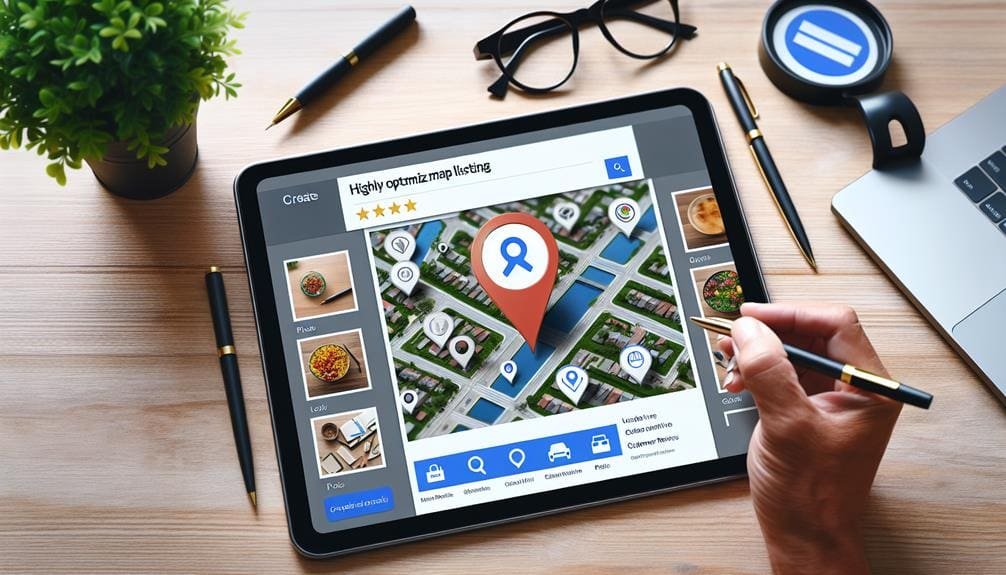Optimize Your Map Listing With Expert Techniques
January 13, 2024 | by Jacob Cavazos

Optimizing your map listing is pivotal in propelling your local presence and drawing in more potential patrons. But how do you ensure your map listing stands out amidst the digital clutter? With many expert techniques at your disposal, from leveraging local search platforms to fine-tuning your structured data, there’s a wealth of strategic steps to explore. But before we dive into the specifics, let’s first understand the critical role your map listing plays in shaping your online visibility and customer engagement. So, how exactly can you harness these techniques to maximize your map listing’s potential?
Local Search Platform Optimization
Local search platforms such as Moz, Yext, RIO, RenderSEO, Chatmeter, Uberall, and SweetIQ are essential for managing and ensuring consistent and accurate information across all listings. These platforms are vital in optimizing our map listing and enhancing our local search presence. By leveraging these expert techniques, we can effectively manage our Google Business Profile (GMB), which is crucial for local SEO and improving our visibility on search engine results pages (SERPs).
We can efficiently update our business information, monitor reviews, and maintain a strong local presence through these search platforms. This allows us to provide accurate and up-to-date details to potential customers, which is essential for attracting local traffic. Additionally, these platforms enable us to implement structured data types, such as local business, geocoordinates, postal addresses, and reviews, to enhance Google’s understanding of our content and further boost our local search performance.
Structured Data Implementation
Optimizing our map listings through local search platforms has been crucial for managing and ensuring consistent and accurate information. Implementing structured data types like local business, geocoordinates, postal addresses, and reviews will enhance our local search presence and improve search engine visibility. By incorporating structured data, we can provide Google with a clearer understanding of our content, leading to more accurate and detailed information about our business in search results. This implementation can significantly increase clicks, impressions, and conversions in local search, ultimately improving our online visibility and customer engagement.
Utilizing structured data is a powerful technique to enhance our local search presence. It helps search engines better understand the context of our content, allowing for improved display of our business information in search results. With expert implementation of structured data, we can ensure that our map listing stands out, providing potential customers with the most relevant and comprehensive information about our business. This approach is essential for maximizing the impact of our map listing and staying ahead in the competitive local search landscape.
Google Business Profile Optimization

To enhance visibility and engagement in local searches, it is essential to ensure that your Google Business Profile contains accurate and up-to-date information. When optimizing your Google Business Profile, consider the following expert techniques:
- High-Quality Content: Utilize high-quality photo content and regularly update information to engage potential customers and improve the overall appeal of your profile.
- Structured Data Types: Implement structured data types and local business schema to enhance Google’s understanding of your content, which can significantly improve your performance in local search results.
- Local Keyword Optimization: Utilize local keyword optimization and hyper-local content to specifically target and attract potential customers in your area, increasing the relevance of your profile in local searches.
- Performance Monitoring: Regularly monitor and analyze performance using tools like Google Analytics and Google Search Console to make informed decisions and optimize your local search engine optimization (SEO) strategy.
Listing Audit and Management
After optimizing your Google Business Profile with high-quality content and local keyword optimization, the next crucial step is to conduct a thorough audit and effectively manage your listings across local search platforms. Regularly auditing your listings ensures that the information remains accurate and consistent across various local search platforms, enhancing your visibility in search engine results pages for local businesses. Utilize structured data types to provide search engines with detailed information about your business, improving the chances of your business listing appearing in relevant local searches.
Optimize your Google Business Profile with complete and up-to-date information, high-quality photo content, and regular updates to maintain a robust online presence. Additionally, responding to positive and negative reviews is essential for building trust and managing your online reputation effectively. Engaging with customers’ questions and answers demonstrates your commitment to providing excellent service and can influence potential customers’ decisions.
Furthermore, utilizing Google Posts and event schema with EventStatus attributes can keep users informed about the status of scheduled events, adding another layer of engagement and information to your local listings. Lastly, verifying your Google Business Profile and regularly monitoring its performance is vital to effective listing management.
Hyper-Local Content Strategy

Developing a robust hyper-local content strategy is essential for maximizing visibility and engagement with nearby potential customers. To achieve this, we should:
- Create unique and high-quality hyper-local content tailored to each specific location. This enhances visibility among nearby potential customers and demonstrates a deep understanding of the local community.
- Incorporate hyper-local terms in our on-page optimization strategy, including headings, titles, metadata, image alt text, and text. This approach significantly boosts local search visibility and improves the chances of appearing in local searches.
- Develop COVID-related content to build trust and demonstrate the adoption of appropriate precautions. This contributes to a positive brand image and reassures customers of our commitment to their safety.
- Utilize Google Posts on our business listing to raise awareness of special events or promotions. This increases engagement with potential customers and effectively drives traffic to our location.
Frequently Asked Questions
How Do I Optimize My Google Maps Listing?
We improve our Google Maps listing by optimizing with local keywords, encouraging customer reviews, adding high-quality business photos, ensuring map accuracy, selecting relevant categories, maintaining NAP consistency, defining service areas, including website links, optimizing Q&A, and analyzing Google My Business insights.
How Can I Improve My GMB Listing?
We can improve our Google My Business (GMB) listing by actively managing reviews, optimizing images, obtaining local citations, selecting relevant categories, ensuring NAP consistency, utilizing Google posts, managing Q&A, offering virtual tours, enabling appointment booking, and monitoring reviews.
How to Do SEO for Google Maps?
We optimize our local business listing for Google Maps using location targeting, map keywords, and mobile optimization. Our approach focuses on ranking factors, user engagement, NAP consistency, review management, geotagging images, and local citations.
What Is Google Maps Optimization?
Google Maps Optimization enhances our online presence through local search strategies. We manage business information, improve location accuracy, and engage mobile users for better map visibility. Analyzing competitors and customer reviews optimizes map rankings and user engagement.
RELATED POSTS
View all



